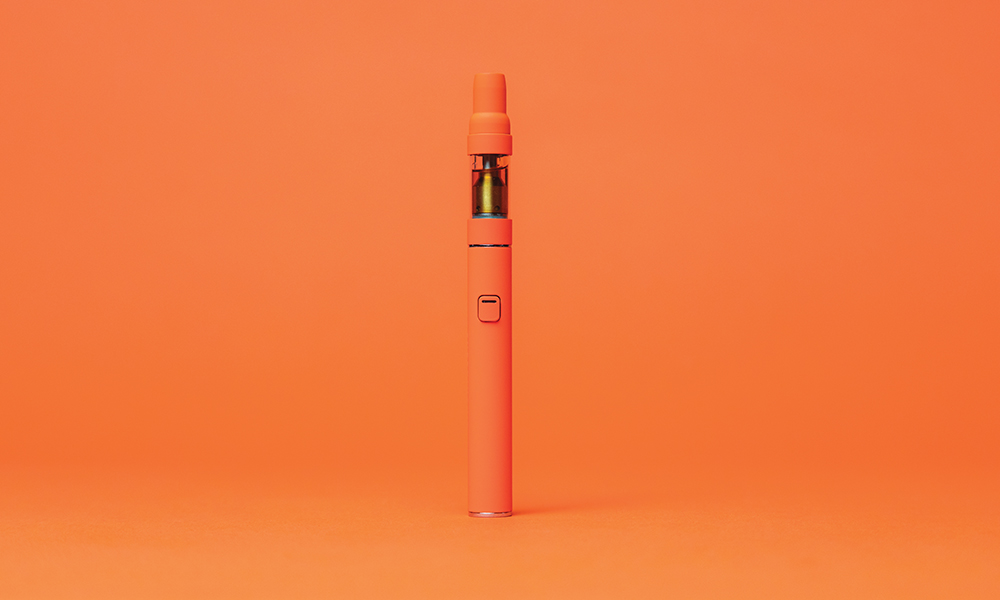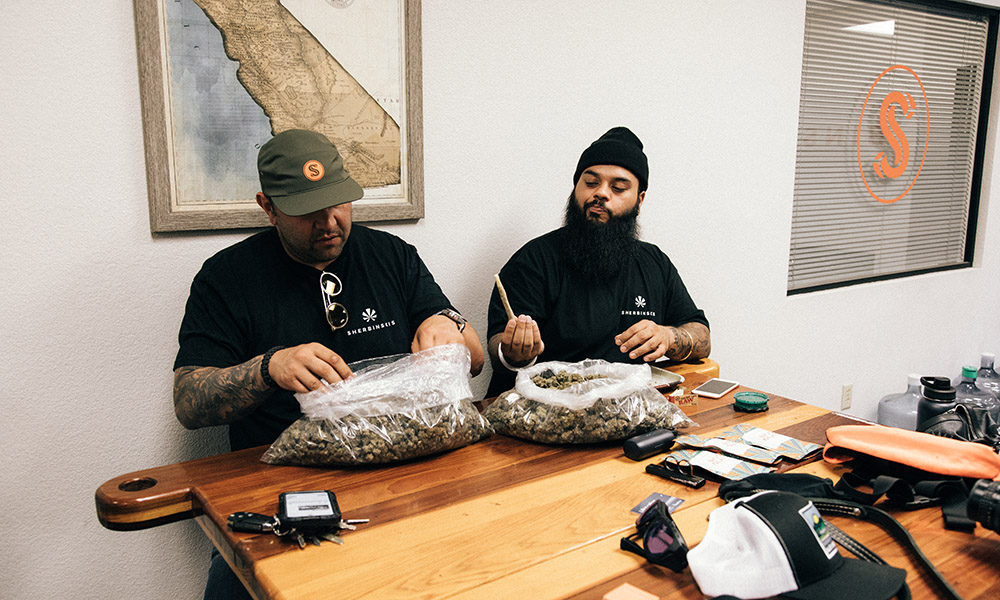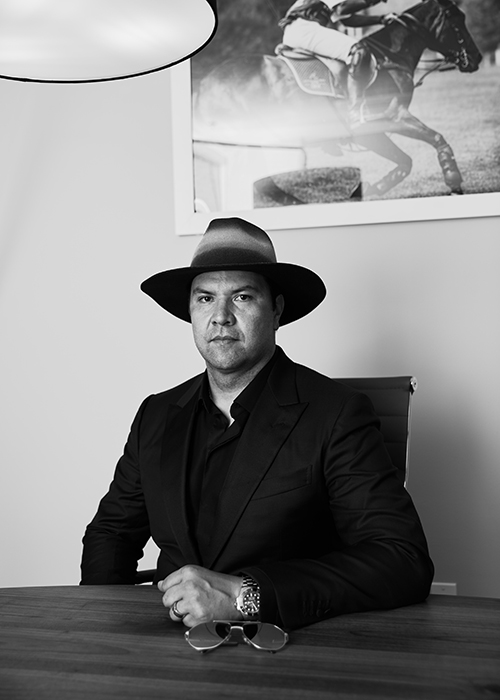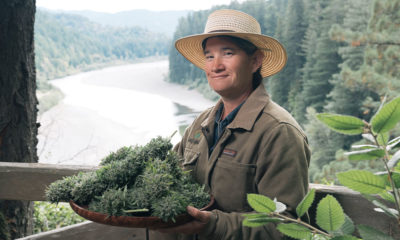On the High End: How Sherbinski Made Himself Into a Top Cannabis Brand
How Sherbinski took his success breeding Gelato into fashion, hip-hop and retail.
In the early 2000s, that golden age of Proposition 215 cannabis in California, Mario “Mr. Sherbinski” Guzman was a regular supplier for San Francisco’s legendary Vapor Room. Back then, nobody had heard the name Sherbinski and the notion of a cannabis brand was still an abstraction. Today, nearly two decades later, his company Sherbinskis is on the short list of still-relevant adult-use brands with uninterrupted roots in California’s self-regulated 215 market.
But before Sherbinski’s cannabis was getting name-dropped in rap hits and sold through fancy department stores, Afgoo cold water hash washed from Sherbinski bud by the man himself was a menu staple at the Vapor Room, and a crucial part of my daily routine. For years, the best part of waking up was smoking a bowl of chocolate-black bubble hash with a cup of tar-black coffee on a rickety fire escape overlooking the intersection of Oak and Fillmore streets.
I’m thinking about this memory as I catch myself staring dreamily out the storefront window of a greasy spoon breakfast joint in East Oakland, clutching a white ceramic cup of hot black coffee at a rickety two-top table by the door. I’m waiting for Sherbinski — he’s a few minutes late, I’m a few minutes early — and draining my third cup of coffee, the caffeine from the first two cups already waltzing wildly with the cannabinoids from my morning dab. I’m eagerly eavesdropping on a couple arguing a few tables down when Sherbinski blows through the swinging doors like a Wild West sheriff, radiating the casual swagger of a resident DJ at that nightclub you aren’t cool enough to even stand in line for.

Despite a powerful too cool for school aura, Sherbinski also exudes a sincere humility that falls just short of self-deprecation when he speaks about the success of his work, particularly the way his Gelato phenotypes have become a touchstone and status symbol for rappers and other tastemakers with a taste for top shelf sh*t.
To hear him tell it, Gelato is just one of those special strains that inspires fanatical devotion in some people, and through a convergence of geography, personal connections and work ethic, some of those people are top-selling music artists and fashion influencers.
“It just took a lot of work and white-glove service when it came to providing our products,” Sherbinski told me. “I never had to give a lot of product away, I was just in the right place.
“In the bay, a lot of musicians come through here and we’d get the call when they were in the studio and we’d be there,” he said. “It was always really natural and organic. When artists are in the studio and naturally enjoying the product they’re smoking, it’s gonna organically end up in the songs.”
Although he’s entering a new stage of his career, he said he has come to truly appreciate the experience of watching the Gelato strain grow into a household name.
“For me, it was the songs. You hear one on the radio and one song becomes five and then ten becomes twenty and now it’s pretty common to hear it — just a few weeks ago, Travis Scott and Future came out with a song talking about Gelato in there,” he said. “It’s nice to feel like Gelato is cemented into our culture and I embrace it.”
Coming across as humble is uncommon enough for any successful businessperson, but particularly unusual given the dizzying heights of tangible success Sherbinski has reached in an industry where even the illusion of achievement is often enough to elicit flashy self-celebration. But through our whole conversation, he seems to regard his career as a beautiful blur of serendipity, largely propelled by his desire to promote access and education in the early days of San Francisco’s golden age of cannabis.
“I stuck my neck out way before people were doing it and said, ‘Hey, I’m a grower,’” he said. “[But] when you have people come to you and say, ‘Your product helped me with my ailment — these flowers are my favorite, they help with my PTSD — how can you not be humbled by that?”
With Prop 215 as we knew it all but a hazy memory now, Sherbinski sits at the nexus of a hectic whirlwind familiar to anyone who’s spent any time around entrepreneurs. The persistent beeping and buzzing of his cell phone provides a steady backdrop to our conversation, and he is undoubtedly “in demand,” but his personal energy is almost meditative, like he’s floating above it all, soaking it in and easing gently into what’s shaping into a lucrative second act.
A Different Breed
Part of what sets Sherbinski apart from most other growers and breeders I’ve spoken to is his laissez faire approach to phenotype selection. Where most breeders are hunting a single white whale, he’s curating a menagerie of sensations and flavors — variations on a shared theme — like the four first-gen Gelato phenos that made the final cut: Acaiberry (Gelato pheno #49), Mochi (#47), Bacio (#41) and Gello.
“The Gelato has gotten so famous, and what I did — which I didn’t see a lot of people do before — I didn’t just pick the best pheno,” he said. “I was like, ‘No, all these phenos are awesome and they all do different things.’ It’s not that different from two models having kids — each kid is probably going to be fire, so how do you pick out of that? That’s kind of how I look at selection.”

That inclusive approach to pheno hunting is still a central thrust of Sherbinski’s latest genetic quest, but these days he has more space to work with and more data to draw on when making selections.
“We pared down our final selections to 100 plants. From there, we pared the selections down to 30. We grew those out and tested them for a full terpene and potency profile. I use science to help me select the right pants,” he said. “I can’t just be like, ‘That’s so frosty and has big nugs and tastes good, I want that,’ and then it’s pulling 16 percent [THC] consistently. Sometimes something isn’t looking that good, but it’s testing 27 percent first round test, or there’s some terpene in there that’s just like, ‘Oh my god.’”
Collaborative Crosses
Gelato is about to go global. Through a collaboration with Dinafem, a seed bank based in Barcelona, Spain, Sherbinski is releasing first-generation Gelato seeds to more than 50 countries. While the Sherbinski legacy has deep roots in San Francisco’s Sunset District, he said he’s interested in making moves wherever he sees a smart one. It’s a philosophy that’s spreading his work worldwide, but it’s also led him just a few hours north, to the world-famous Emerald Triangle, where his partners at the Humboldt Seed Organization are based.
Because, in addition to releasing females from the first generation of Gelato phenos, he’s going to be producing new generations using HSO genetics, a process that’s already produced promising results. I haven’t yet tried the next generation of official Gelato crosses, but given the wide scope of the pheno hunt that produced them — roughly 3,000 seeds — and the prestigious lineage of the new genetic material used, I’m eagerly awaiting the opportunity to taste the new flavors.
“I took a Mandlebrot OG clone that HSO provided and that male went back to all of my original genetics, and I selected about five new phenos from a roughly 3,000-seed pheno hunt,” he said, adding that he’s never used so many precise metrics to select winners.
“I boiled it down to about 40 keepers out of the new generation and tested them all for terpene profile and potency, then took portraits to look at the bag appeal,” he said. “It’s the first time I’ve used all those data points to select.”
The HSO collaboration is truly exciting for Sherbinski, who sees it as a way to share his genetics so people can actually grow from them, albeit on a release schedule that allows him the first crack at his own work.
“All the other people who have used Gelato, that’s either a bag seed or cuts I never really used, like the #33 and the #45, which were basically just throwaways for me,” he said. “I’ve never done any projects with anyone — they might have bag seed: It was either stolen or a bag seed.”
In addition to people bootlegging his genetics through stray seeds and stolen cuts, there’s also the time-honored cannabis industry tradition of tacking a trendy prefix or suffix on last year’s strain. Thanks to the popularity of Sherbinski’s Sunset Sherbert and Gelato strains, we’ve seen a whole lot of Orangelato, Tangelato, Sherbtane, SherbWreck or, of course, Sherblato — but they’re all fugazi. Sherbinski didn’t collab on any of them, despite numerous false claims to the contrary.
He said the scammers used to get to him, but over time he’s learned to accept all of the bootleggers and bullsh*tters as the cost one pays to be the boss.

“Instead of getting mad that someone found a bag seed and has a ten-light grow and is selling my shit, I look at it like, ‘Hey man, I’m glad you can get $400 more per pound on your shit.’ It’s not gonna f*cking stop me from making money,” he said. “When you live in fear, that’s how you act like that six-light grow is gonna kill you or take you out the game, and it’s all out of fear, man. I just chose to not live that way.”
But that doesn’t mean he’s completely given up on protecting his intellectual property.
“I have a new strain. I don’t want to announce the male yet because I know that people might possibly have it and…” he smiles. “You know how people are. Next thing you know, before I even drop it, they’ll be selling the seeds.”
Clout vs. Commodity
Despite his recent success, Sherbinski is struggling through the growing pains of California’s adult-use market with everyone else. However, his view of the new stage cannabis is entering contrasts sharply with the frustration and pessimism of many long-time industry participants. He’s acutely aware of the challenges presented by the new regulations, but from where he’s sitting, some of the more virulent detractors of those new rules are growers feeling left out.
“What I see? Most of my OG homies who were like ‘naw naw naw’ [about pursuing licensing] and never wanted to go in that direction, they’re feeling it right now. They regret not making bigger moves earlier to be farther along now,” he said, adding that it’s particularly difficult to swallow for guys who stayed underground only to watch smaller or less accomplished cultivators come into a big investment.
“They see everything moving now — see these people that were a fraction of what they were or could have been selling companies for millions of dollars,” he said. “So, how’s that gonna make people feel? They’re like, ‘Little Billy over there had the f*cking Banana Skunk and this other sh*t that no one cared about’ but now he’s the business.”
It’s an uncommon sentiment at a time when running a legal cannabis company can feel like navigating a narrow mountain ridge with steep drops on either side. To your left, there’s braving the legal uncertainty, volatility and danger of the illicit market. To your right, the very real possibility of hemorrhaging all your capital and then some before you ever make a dime — maybe before you even make it to market.
But as cannabis continues its transformation into a commodity, Sherbinski believes basic business skills are going to be rewarded as much (if not more) than more subjective factors that were previously make or break, like product quality and an established reputation within “the culture” — ironically two of the main factors in his own rise to prominence.
“How many dispensaries do you see now that are popping up out of nowhere and nobody knows these guys? But they’re cranking — why? They know how to run a biz. They know how to sell it,” he said. “How much is ‘clout’ gonna matter when cannabis is commoditized? But I do see that people are attracted to the brand — they still need brands.”

But selling high quality cannabis is obviously a big part of Sherbinski’s brand identity and an enduring feature of his business model. A collaboration with ultra-chic cannabis brand Beboe means an exclusive Sherbinskis blend will be gracing the shelves of luxury retailer Barneys, at their Beverly Hills tragicomically hip head shop, The High End — right next to the $1,000 bongs and $2,000 grinders. (Because Barneys Beverly Hills does not have a dispensary license, THC products at their store are delivered later by a licensed cannabis delivery business.)
Sherbinski is no stranger to the intersection of high fashion and streetwear. He already made a splash with his Sherbinskis Air Force One sneaker (which sold out in a couple hours) and cites Virgil Abloh, the artistic director for Louis Vuitton’s menswear line and founder of the Off-White label, as a major inspiration for his approach to branding. With his own club slated to open blocks from the Supreme store and the Barneys collab under his belt, Sherbinski is definitely breaking new ground for the cannabis industry.
And just as Sherbinski is braving the stormy seas of a shifting cannabis landscape, Barneys is navigating the perils of being a luxury retail chain in a down market. In August, the company announced it was downsizing its New York flagship in the face of a $33 million rent bill. Their move into the cannabis sphere is a bold one that could be a game changer, and for Sherbinski, it’s the same. The collaboration makes perfect sense: There were already a couple high end dispensaries calling themselves the “Barneys of bud,” so why not get in the game, and why not team up with weed’s Louis Vuitton?
“It’s nice to be defining something for Beboe — it’s much different than what I’m used to, which is highest potency, strongest terpene profile, which is what I brought to them first, but it wasn’t right for them and the Barneys brand,” he said. “They wanted a blend that had high CBD with a sativa dominant, so I came up with the Beboe Blend by Sherbinski. That’s what I’m moving into, finding genetics for different brands that want effects that cater to their distinct market.”
Leaving a Legacy
Sherbinski feels he’s been privileged with the opportunity to make an impact on cannabis — something he cares about deeply — and now he wants to preserve his contributions.
“I’m getting older, and in the end, you want to leave a legacy behind and something like what’s happened with Gelato is so special,” he said. “When you’re younger, it’s about being cool and hanging out with artists, but when you get older and you’ve been to the parties and experienced all that, you’re like, ‘What do I want to do now?’”

When he finally got around to asking himself that question, the answer was clear: share Gelato with the bud lovers of tomorrow.“I want to get future generations the original, so when they ask why was it so special they can get a real answer — you’re going to be able to experience exactly why for generations to come,” he said. “I don’t consider myself an expert breeder… I’m not the best, I’m just a regular dude, right place, right time; SF Sunset District, early 2000s, happened to meet the right people and we made magic.”
TELL US, have you tried Sherbinskis?
Originally published in the print edition of Cannabis Now. LEARN MORE


























